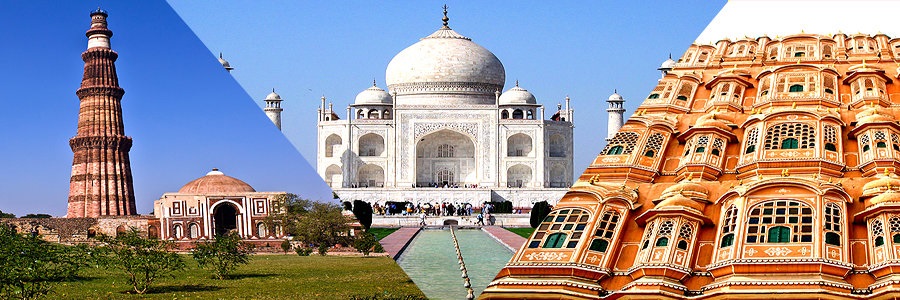

Classical India Tour
Places to See: Delhi - Jaipur - Agra - Gwalior - Orchha - Khajuraho - Varanasi - Delhi

Classical India Tour: Complete Itinerary
Day 01: Arrival Delhi
Arrive Delhi international airport by flight, meet & greet with our office representative, assistance and transfer to hotel. (Hotel check in/ out time 1200hrs, early check in subject to room availability)
Later tour of Delhi visit Red Fort the residence of the Mughal emperor for nearly 200 years, until 1857. Cycle rickshaw ride in Chandni Chowk Bazar. Visit Jama Masjid one of the largest mosques in the world, built by Shah Jahan to dominate his city. Raj Gath the memorial of Mahatma Gandhi where he was cremated after his assassination. Humayun’s Tomb an early example of Mughal architecture build by wife of Humayun, the second Mughal king. Drive through Rajpath "Kingsway" a VVIP area of Delhi which includes President House and Parliament. India Gate the 42m high stone "Arch of Triumph", erected in the memory of Indian soldiers who died in the First World War. Qutab Minar the building complex dated back on the onset of Muslim rule in India and are fine examples of Afghan architecture. Lotus Temple a lotus-shaped outline has etched itself on the consciousness of the city's inhabitants, capturing their imagination, fuelling their curiosity, and revolutionizing the concept of worship. [Red Fort & Lotus Temple remain closed on Monday's]. Overnight at Hotel.
Day 02: Delhi – Jaipur (265kms/ 5hrs approx)
Breakfast at hotel, drive to Jaipur, check in at hotel. Rest day free and easy for personal activities relax etc. Overnight at hotel.
Day 03: Jaipur
Breakfast at hotel. Visit Amber Fort and enjoy Elephant Ride. Raja Man Singh the Rajput commander of Akbar’s army constructed the fortress palace in the end of 16th century. Amber is superb example of Rajput architecture, situated on a hilltop, overlooking a lake. Amber Fort is known for its unique artistic style, blending both Hindu and Muslim (Mughal) elements, and its ornate and breathtaking artistic mastery. The fort borders the Maota Lake.
Jaigarh Fort or Fort of Victory considered to be one of the most well fortified structures in India. The magnificent fort was constructed by Sawai Singh of Jaipur in 1726 in order to tighten the security of Amber and Jaipur. Situated on the top of the hill the fort provides the stunning view of the Jaipur town and magnificent amber fort. The main highlights of the fort are massive Cannon, fortification, museum, palaces, temples and the magnificent water tanks. Jai Van is claimed to be the largest cannon on wheels in the world. The length of the barrel of this cannon is 20 ft. 2 inches, the diameter 8 ft. 7 inches and it weighs 50 tons. The range of the gun is 22 miles and it consumes 100kgs of gunpowder for every shot.
Afternoon city tour of Jaipur, visiting Main tourist attractions of Jaipur. City Palace situated in the heart of the old City, it occupies about one seventh of the old city area. The palace is a blend of Rajput and Mughal architecture and house fine collection of textiles, costumes and armory. Palace of the Winds built in 1799, by Maharaja Sawai Pratap Singh, is the most recognizable monument of Jaipur. The 5 storied stunning semi-octagonal monument having 152 windows with over hanging latticed balconies is a fine piece of Rajput architecture. Observatory Maharaja Jai Singh was a great astronomer of his time. He built here extraordinary (and very accurate) stargazing Observatory here named as “Jantar Mantar”. Laxmi Narayan Temple known for the intricate marble carvings in white marble, popularly known as Birla Temple. Overnight at hotel.
Day 04: Jaipur - Fatehpur Sikri - Agra (235kms/ 5hrs approx)
Breakfast at hotel drive to Agra, Enroute visit to Fatehpur Sikri: built by Emperor Akbar in 1569 and abandoned after 15 yrs. Due to scarcity of water. Predominately, a red sandstone construction sprawling over a huge area, the architectural style is very much in tune with emperor’s dream & partakes of both Hindu & Muslim styles. See the graceful buildings including Jama Masjid, Tomb of Salim Chisti, Panch Mahal & other places.
Continue drive to Agra, on arrival check in at hotel. Later visit Taj Mahal – One of the Seven Wonder of the World was build by Shah Jahan in 1631 AD and was completed in 1651. This symbol of love was build in memory of his wife Mumtaz Mahal. Described as the most extravagant monument ever build for love. It was constructed by Mughal Emperor Shah Jahan as a memorial to his queen Mumtaz Mahal, made out of white marble took 22 years to complete. Ustad Ahamad Lahori, a Parsian Architect, is said to be the main designer and planer of this magnificent memorial. On full moon night, the glory of the Taj is at its best. (Taj Mahal remain closed on every Friday)
Agra Fort - build by the famed Mughal Emperor Akbar in 1565AD, the fort is predominantly of red sandstone. Construction of the massive red sandstone Agra Fort on the bank of the Yamuna River was begun by Emperor Akbar in 1565, though additions were made up until the rule of his grandson, Shah Jahan region it has partially become Palace. The fort presents a good sampling of their favoured architectural styles. Akbar drew on Islamic and Hindu traditions and the result is eclectic. By Shah Jahan's time the style had become so homogenized that it is impossible to separate the Hindu and Muslim strands. The Diwan-I-Am (public audience hall) the beautiful Diwan-I-Khas (private audience hall) were also added by Shah Jahan. Overnight at hotel.
Day 05: Agra – Gwalior – Orchha (237kms/ 5hrs approx)
Breakfast at hotel, drive to Orchha, en route visit Gwalior. The Fort: Standing on a steep mass of sandstone, Gwalior Fort dominates the city and is its most magnificent monument. The magnificent outer walls of the Fort still stand, two miles in length and 35 feet high, bearing witness to its reputation for being one of the most invincible forts of India. This imposing structure inspired Emperor Babar to describe it "the pearl amongst the fortresses of Hind."
Within the fort are some marvels of medieval architecture. The 15th century Gujari Mahal is a monument to the love of Raja Mansingh Tomar for his Gurjar queen, Mrignayani. Man Mandir Palace, built between 1486 and 1517. Teli ka Mandir: The Teli ka Mandir is a 9th century edifice, towering at 100 ft high. Sas-Bahu-ka-Mandir, built in 11th century dedicated to Vishnu. Tomb of Gaus Mohammad and the Mausoleum of Tansen. Another landmark is the historic Gurudwara Data Bandhi Chhod built in the memory of Guru Hargobind Sahib, the 6th Sikh Guru who was imprisoned here by Jehangir for over two years.
Continue drive to Orchha. On arrival check in at hotel. Later visit Orchha Fort: A wonderful example of a medieval fort palace, within the fort are the first buildings to explore. The tiered Jahangir Mahal was built in 1606 to commemorate the visit of Emperor Jahangir in 1606. The Raj Mahal, to the right of the courtyard, was built by Madhukar Shah and has bold colorful murals inside. The third palace, is the Rai Praveen Mahal, which is a two storey brick structure set in the gardens of Anand Mahal. Of the many temples within the fort, three are especially worth visiting. The Ram Raja Mandir was originally a palace and became a temple more by accident than design. An image of Ram was installed while the temple, The Chaturbhuj was being built for it. For some reason the image could not be moved from the palace and despite its spires and ornate decoration became a sacred place. Linked to the Ram Raja is the Lakshminarayan temple, the interiors of which have some of the best preserved murals and wall paintings in Orchha. Overnight at hotel.
Day 06: Orchha – Khajuraho (178kms/ 4hrs approx)
Breakfast at hotel, drive to Khajuraho check in at hotel.
Afternoon sightseeing of Khajuraho, visit eastern, western & southern group of temples. Khajuraho, home to most famous of India’s temples on account of their remarkable erotic sculptures, lies in a rich, well watered plain. The temple of Khajuraho are india’s unique gift to the world, representing, as they do, a paean to life, to love, to joy ; perfect in execution and sublime in expression.
Khajuraho temples were built in hundred years, from 950 to 1050 AD. Only 22 of the 85 original temples have survived the ravages of time. Each temple stands on a high platform. There are three main parts in each temple, the entrance (ardhamandapa), assembly hall (mandapa) and sanctum (garbha griha). The Khajuraho temples are made of sandstone. The builders didn't use mortar: the stones were put together with mortise and tenon joints and they were held in place by gravity. This form of construction requires very precise joints. The columns and architraves were built with megaliths that weighed up to 20 tons.
Today, the temples serve as fine examples of Indian architectural styles that have gained popularity due to their explicit depiction of sexual life during medieval times. Locals living in the Khajuraho village always knew about and kept up the temples as best as they could. They were pointed out to an Englishman in late 19th century but the jungles had taken a toll on all the monuments.
Day 07: Khajuraho – Varanasi (Flight)
Breakfast at hotel, transfer to airport to board flight for Varanasi. On arrival assistance and transfer to hotel. Rest day free and easy for personal activities relax etc.
Evening Ghats’s & temples visit, attend Holy Ganga Aarti; Every evening, a magical aarti is performed at Dasashwamedh Ghat. Halt your boat right at the steps for the best view. The presiding priests stand on a wooden chauki in the water. To the chant of Sanskrit mantras, and the clash of cymbals and drums, the river is worshipped with flowers, incense, sandalwood, milk and vermilion. First the blazing camphor lamp and then the many- flamed aarti lamps are raised high and then arched back to the water, the dark river reflecting the golden flames as Ganga accepts the worship. Overnight stay at hotel.
Arrive Khajuraho, check in at hotel. Rest day free for personal activities. Overnight at hotel.
Day 08: Varanasi
Breakfast at hotel, excursion to Sarnath: one of the three holiest sites for Buddhists. This is where the Buddha delivered his first sermon in 528 BC. There are many temples here, representing the many cultures where Buddhism is the dominant religious philosophy. You'll find the Tibetans, the Chinese, the Japanese, the Burmese and the Thai have set up centres of learning, monasteries and temples. The Ashokan Pillar here used to be crowned by a capital that had four lions with their backs to each other looking out in the four cardinal directions the capital, now a national emblem for the Indian Union, is in the Archaeological Museum in Sarnath. The Ashokan Pillar, constructed by the legendary King Ashoka (3rd century BC), still stands. There are many stupas here, as is a bodhi tree that is a sapling from the bodhi tree in Sri Lanka. The Bodhi tree is the peepul tree under which the Buddha attained enlightenment. A cutting from the original was planted in Anuradhapura (Sri Lanka), and the bodhi in Sarnath has been grown from a sapling from that.
Afternoon city tour, visit World famous Benaras Hindu University: founded by Pandit Madan Malviya at the turn of the century, also has a new Vishwanath temple. The temple, built by the Birlas, a rich industrialist family, is meant for a caste-less, egalitarian society, Tulsi Manas Temple: Its white marble walls have the verses of Tulsidas’ Ramcharitmanas inscribed on them and Bharat Mata Temple: a modern shrine, inaugurated by Mahatma Gandhi. It has a huge relief map of the Indian sub-continent showing all its rivers, mountains and pilgrimages. Overnight at hotel.
Day 09: Varanasi – Delhi (Flight)
Early morning boat ride and Ghat visit along the Ganges and catch the scene of devotees bathing and praying in the sacred water. Varanasi or Kashi is older than traditions. Varanasi presents a unique combination of physical, metaphysical and supernatural elements. According to the Hindu mythology, Varanasi liberates soul from human body to the ultimate. It is the Ganga Ghats of Varanasi that complement the concept of divinity. Ghats of Ganga are perhaps the holiest spots of Varanasi. The Ganga Ghats at Varanasi are full of pilgrims who flock to the place to take a dip in the holy Ganges, which is believed to absolve one from all sins.
There are number of temples on the bank of the Ganga river in Varanasi. It is believed that people are cleansed physically, mentally and spiritually at Ganga Ghats. It is at the Ganga Ghats where we see life and death together. For thousands of years people have been thronging these Ghats to offer their morning prayers to the rising sun. There are more than 100 ghats along side Ganga in Varanasi. Some of the prominent and popular Ghats at Varanasi are the Dasaswamedh Ghat, Manikarnika Ghat, Harischandra Ghat, Kabir Ghat and Assi Ghat.
After breakfast free for personal activities. As per flight schedule transfer to airport to board flight for Delhi. On arrival at Delhi airport assistance and transfer to hotel. Overnight at hotel.
Day 10: Delhi – Home
Breakfast at hotel transfer to international airport to board flight for your home country.
Searching Availability...












